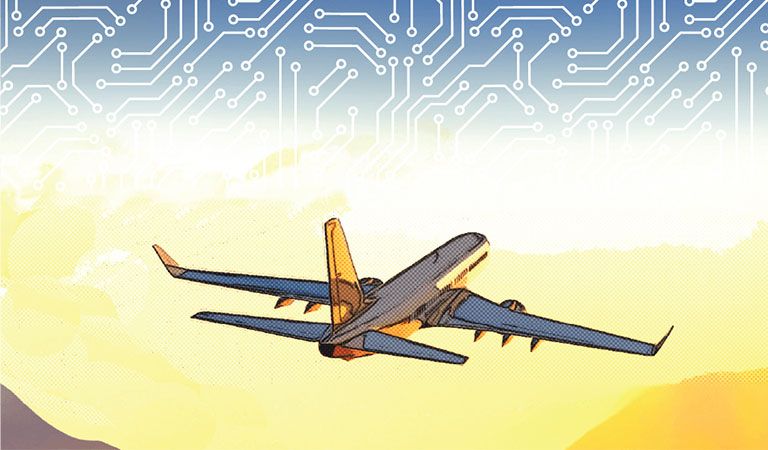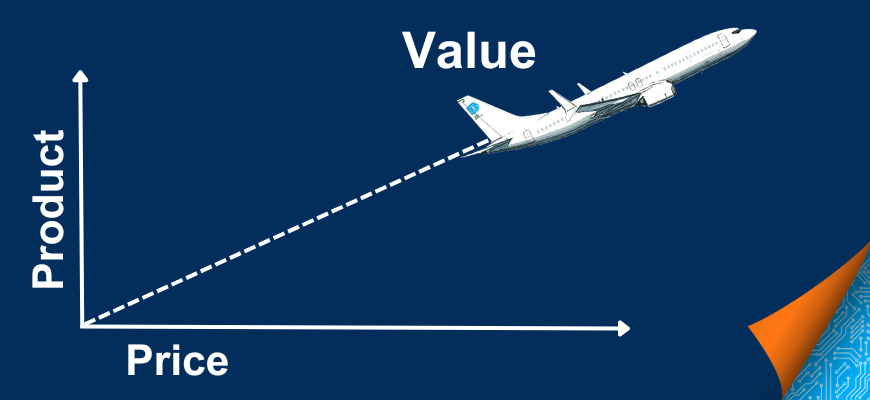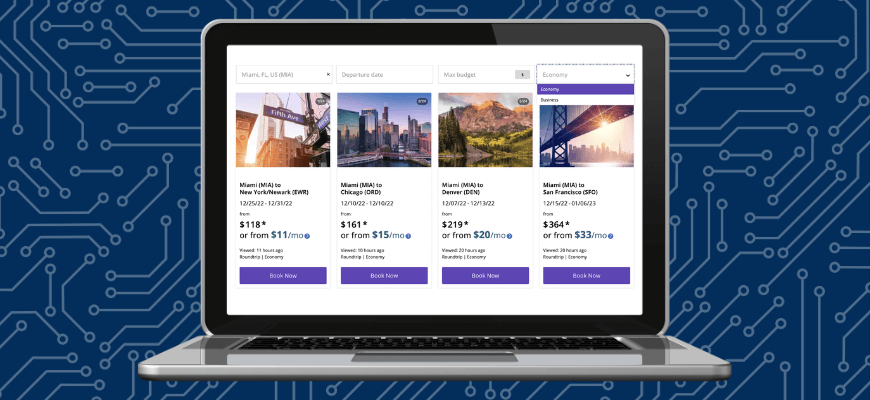Guide to Airline Digital Transformation and Retail Freedom Through Offer Optimization
par PROS Travel
Optimize revenue streams and gain retail freedom through airline offer optimization
Customer expectations of seamless and personalized digital travel experiences are at an all-time high. There is no longer a firm line between business and leisure, and customers are increasingly demanding when they shop, book, and plan their travel.
To meet those demands, airlines need to become strong retailers, improve the customer experience and translate it into incremental revenue. Offer optimization is the performance-driven solution unlocking modern airline retailing, and the time to act is now. Not in the future, but today, and your airline is no exception. Miss the transformation and risk being left behind and out of significant incremental revenue – up to $7 per passenger.
What is Airline Offer Optimization?
To become better retailers, a focus on airline offer optimization is key. And it doesn’t have to be a black box – offer optimization means offering the right product mix to every customer at a revenue-optimal price, regardless of channel. It is the ability to create, price and retail offers that are personalized for each travel request and consistent with an airline’s pricing, channel, and revenue management strategy. It is also the ability to deliver these optimized offers across any airline direct digital or NDC distribution channel during any touchpoint in the traveler journey, from inspiration to post-trip. In other words—offer optimization is the epitome of digital retailing.

Effective offer optimization strategies require airlines to deeply listen to their customers and the markets they operate in, and leverage data to engage with customers where and how they want to purchase travel. To successfully drive this, your airline will need to rethink airline revenue management, ecommerce, distribution, and merchandising and put in place an airline-led retail strategy, focused on offers versus class-based fares.
Challenges of airline offer management
Due to legacy practices of separately managing pricing and inventory, today airlines face multiple challenges in managing offers, unique only to our industry. Legacy technologies that were once powerful mission-critical systems are now hampering the adoption of essential strategies such as dynamic pricing and the use of AI that allow airlines to sift through tremendous amounts of data and create personalized offers. This delays the benefits the airline industry could be reaping from digital commerce and retailing.
Scroll below to learn how to overcome the top four challenges for developing a winning offer optimization strategy. And find out how your airline can navigate the retail transformation process toward airline Offer and Order Management.
The commercial challenge: inability to innovate quickly and differentiate your product
Airline offers can no longer be one-size-fits all – they must be dynamic. To compete beyond price, your airline needs to escape the commodity perception of air travel by differentiating your products and services. Dynamic offer creation gives airlines endless opportunities to capture demand and increase revenues while giving customers exactly what they need at a price they are willing to pay.
However, innovating through dynamic pricing and dynamic bundling today is a challenge even for the most forward-thinking airlines. The majority of airlines struggle to price beyond the letters of the alphabet and are unable to bundle the ancillaries with the highest likelihood of purchase. The ones that mark some progress, take many months, or even years, to launch new products. And that’s only across their own websites, it’s even slower across indirect channels.
The business challenge: lack of offer control due to outsourced distribution
Airlines not only need to create dynamic offers, but also manage how these optimized offers are distributed and presented “on the shelf” across all sales channels – digital and NDC (New Distribution Capability) direct, and indirect. To increase conversion, the channel experience must be personalized to the customers’ needs and also be in line with an airline’s strategies and revenue goals.
However, due to the legacy business model of outsourcing offer creation and distribution to the GDS, many airlines remain handcuffed to control what their offers consist of and how they are presented beyond their website. This leads to no visibility into who the customer is, poor shopping experiences and missed revenue opportunities.
The IT challenge: a complex legacy-dominated technology stack
Creating and distributing offers must be managed through many system and technology integrations that are mission-critical to power an end-to-end airline eCommerce environment. Successful offer optimization requires IT solutions that can scale to seamlessly handle tremendous increases in transaction volumes at a reasonable cost.
However, current retail ecosystems are growing spaghetti architectures of IT workarounds. Airline professionals across both IT and commercial departments indicate that legacy closed systems and the complexities around integration are a significant pain point and hinder retail innovation.
Adopting change: Moving from challenges to revenue opportunities
A customer-centric approach to airline offer management is required. It means a fundamental shift from a siloed approach of managing data records like PNRs (passenger name records) and EMDs (electronic miscellaneous document) to a modern world of customer-centered Offers and Orders.
For airline executives today, this translates into adopting new approaches to creating products and pricing them, but also leading this change across the entire organization: this includes sales, distribution, airline revenue management, digital and marketing.
Where to start with offer optimization
Committing to optimization
Many airlines embark on the transformation journey to Airline Offer and Order Management by putting expensive retail platforms in place as a shortcut to retail greatness. Not to disappoint, but without the adoption of an optimization mindset first throughout the airline commercial organization, no platform will get you to the desired end state.
Offer optimization starts by consciously taking charge of how you create and price products and the effort to be constantly optimizing the process. This approach ensures that the commercial teams at your airline first know what they are looking to achieve with the offer. Then, it’s only a matter of how – choosing the right technologies, partners and going on this journey together.

In this next section let’s explore possible paths for your airline’s offer optimization journey.
How to optimize your revenue streams?
Transitioning from airline revenue management to offer optimization
The priority focus area for airline executives is to boost revenue in an industry where margins are notoriously thin. Optimizing revenue includes evaluating multiple revenue streams like:
- matching individual and group pricing capabilities to these of online retail
- tightening up availability management across channels
- boosting airline merchandising potential.
Let’s take a closer look at these key revenue streams:
From RBDs to class-free RM and pricing: leveraging customers’ willingness-to-pay and continuous pricing
Successful airline revenue management teams need to quickly and confidently adjust to changes in demand, competition, and special events. They can apply revenue management and availability strategies based on AI-driven solutions to keep up with their unique markets and competition and maximize revenue across every flight. By empowering revenue management analysts with AI-powered forecasting and optimization and easy access to drilldown to information that is most important to them, airline executives can increase employee efficiency, so analysts focus on their core expertise – driving revenue.
But there is more to efficiency – it’s about time your airline moves at the speed of digital to start pricing outside booking classes. By leveraging willingness-to-pay science airlines can forecast demand beyond RBDs based on customers’ price sensitivity. This opens exciting new revenue opportunities between fare classes that your airline can tap into through continuous pricing to significantly impact yield and profitability by up to 2%.

From individual to group revenue optimization through dynamic pricing
Airlines need to be able to extract revenue through improved processes and pricing for their group’s business as well. Groups can account for up to 10% of an airline’s revenue. Streamlining the pricing, quoting, and booking process through science-based dynamic pricing for groups is a next logical step to capturing demand faster and in a revenue-optimal way. By creating a smooth workflow between travel agents, sales managers, and revenue managers, airlines can increase productivity by 70% while driving increased group conversion rates.
Dynamic ancillary science to upsell and cross-sell
Airlines are also looking for opportunities to boost ancillary sales. Ancillary revenue now represents a $102.8 Billion opportunity and 15% of global airline revenue, according to IdeaWorks Company / CarTrawler Research. Successful strategies include identifying upsell offers during various parts of a customer’s shopping and booking journey and dynamically pricing and bundling the right ancillaries based on AI-driven insights to increase the likelihood of purchase. And the most relevant ancillary offer at the right price translates into incremental ancillary revenue and improved customer experience.

How to gain your airline’s retail freedom?
Taking control of airline offer creation, distribution and retailing
A key focus area for airlines is to take charge of how they create and distribute any optimized offer across their sales channels. To do that many airline executives are looking to shift from a traditional model of distribution, which includes a lot of intermediaries, to a more direct approach through NDC. By shifting to airline-led offer creation and distribution airlines can gain greater visibility into who the customer is and greater flexibility to present more personalized products, pricing, and customer experiences.
Taking back control requires implementing processes and technology that are focused on control, scalability, and personalization. It translates into capabilities that allow your airline to be the sole source of truth for each offer and your teams – the strategic owners of what offers reach each sales or distribution channel, down to each seller.
To meet the rising digital-first demands of customers your airline needs to be able to scale distribution across any direct and indirect channel. In a legacy setup this triggers exponential rise of distribution cost. In the NDC reality your airline needs an effective, cost-efficient way of getting your best offers at scale across any shelf, be it your website, an online travel agency (OTA), a metasearch (MSE) or and NDC-connected partner. The right pricing and shopping solutions deliver tailored offers at millisecond response times at a reduced cost of sale. This allows airlines to revamp direct shopping and implement NDC (New Distribution Capability) to directly connect to the entire distribution ecosystem, while putting away the concerns for managing high volumes of search transactions and maintaining pricing and availability accuracy.
Finally, as airlines progress in their retail journeys, they need to be able to dynamically respond to demand. Dynamic pricing is a key tool that leading airlines are employing to drive their distribution strategy. It ensures the right offer at the right price for that context, regardless of channel. In a digital-first environment, airline eCommerce must be dynamic, not static, and limited to pre-filed fares.
Consider the Customer Experience
In addition to revenue optimization and distribution control, airlines need to consider customer experience as it relates to airline eCommerce. This means creating and distributing dynamic offers through smart UX and UI that powers an airline’s website and mobile application.
Airlines can improve the customer experience through customer journey mapping and better understand how travelers research, shop, purchase and manage trips. Through that process, coupled with conversion rates and web performance metrics, they can tailor an airline eCommerce‘s UX. Some areas to consider are a seamless digital experience that includes a simpler, but flexible booking flow and additional customer touchpoints to upsell personalized airline ancillary products and services. By incorporating rich content, airlines can also see an uptick in conversion rates as customers can see exactly what they will purchase. Good eCommerce UI can turn lookers into bookers, where poor UI can negatively impact the sell-through of even the best product at the optimal price.
Customer Acquisition and Offer Marketing
For airlines, direct customer acquisition through offer marketing is the component that starts any customer retail experience journey. As cost of travel is a primary decision driver for many customers, airlines need to leverage the ability to market dynamic offers to the right customer at the right time and drive conversion.
With dynamic offer marketing capabilities, airlines can directly communicate their offers to customers and drive them to their direct channel where they can easily find the best offer and complete their purchase, increasing direct sales and earning future customer loyalty.
Offer marketing technology also captures important shopping data that can be utilized in future forecasting and offer optimization. Based on the feedback loop of what offers were presented, booked, and abandoned, airlines can optimize offers continuously so that they can create the best offer for every customer, across every channel in a way that maximizes airline revenue and profitability.

Why should your airline adopt an offer optimization strategy?
In a hypercompetitive volatile market with constant changes, airlines must respond to market opportunities with speed, real-time accuracy and in a personalized manner. The digital imperative is urging airlines to be innovative, flexible and in-command of the way they create and distribute their products and services.
Airline offer optimization enables airlines to drive revenue growth, increase productivity, streamline the customer experience, and gain greater control and flexibility of their distribution channels.
Through offer optimization, airlines can leverage data-science and AI to bring digital transformation to life and deliver real-time dynamic and optimized offers across direct and indirect sales channels. The result: maximized revenues across every flight and increased wallet share of each passenger.
Offer Optimization has been proven to bring the following results to airlines:
- Offers delivered at sub-second response time
- Distribution cost optimized by millions of dollars
- 3-4% revenue lift with best-in-class revenue management forecasting
- 70% reduction in group sales processing time
- 1-2% revenue lift from implementing real-time dynamic pricing
- 45% conversion rate increase across metasearch from consistent distribution
To guide your journey to airline offer optimization, we have outlined the PROS approach in this video:
What makes PROS your partner for airline retail freedom?
Over the last 3 decades, we have seen the complexity of the airline industry rise across all aspects of the business: revenue management, sales, distribution, marketing and eCommerce, hampering your airline’s ability to innovate.
PROS vision is to enable airlines to be true retailers through offer and orders. To do this, PROS delivers the first Airline Offer Optimization solution, part of the PROS Platform for Travel.
Designed as an open, modular, and AI-powered technology the PROS AI Platform for Travel hands retail control back to the airline. PROS travel solutions infuse AI and machine learning insights, so your airline can fully manage how you create, price and present offers. The PROS promise, should we embark on your retail freedom journey together, is:
- Open partnership approach: together, let’s build a legacy-free roadmap to offers and orders
- Full offer optimization and creation control: gain 360° offer control and optimization powered by AI
- Future-proof retail transformation: innovate for tomorrow while undisrupting operations today
By gaining retail freedom your airline can maximize revenue, reduce costs and drive customer satisfaction and loyalty for your airline brand.
